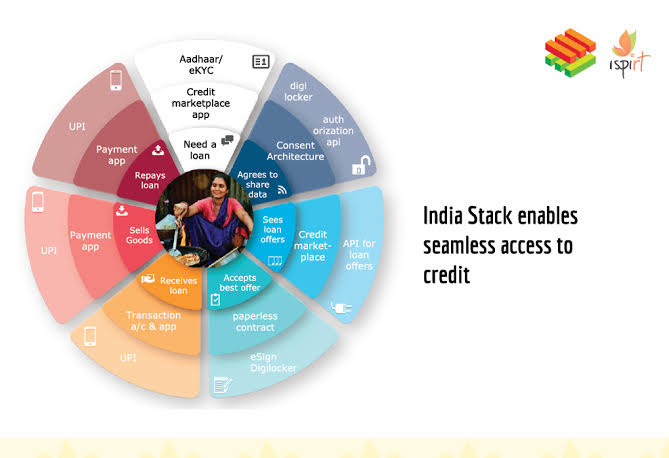Contents
- 1 Introduction
- 2 What is Digital Public Infrastructure (DPI)?
- 3 What has been the advantage of use of Digital Public Infrastructure in India?
- 4 What are the challenges associated with Digital Public Infrastructure in India?
- 5 What should be done to improve India’s Digital Public Infrastructure further?
| For 7PM Editorial Archives click HERE → |
Introduction
Digital Public Infrastructure (DPI) has been India’s most powerful tool, in its endeavour to give social protection to every Indian. India in its G20 presidency showed the world that, Digital Public Infrastructure (DPI) will be an important part of the international development architecture of the future. India highlighted its unique DPI initiatives, such as digital ID (Aadhaar) and Unified payment infrastructure (UPI), in the meetings of G20 Digital Economy Working Group (DEWG).
What is Digital Public Infrastructure (DPI)?
Digital Public Infrastructure- DPI is a set of “shared digital systems” used to drive development, inclusion, innovation, trust, competition, respect for human rights and fundamental freedoms. (Definition of DPI adopted by the G-20 Framework for Systems of Digital Public Infrastructure)
The concept of Digital Public Infrastructure is not new- Though the term Digital public infrastructure is relatively new, the concept is an old one.
1. The internet, powered by common protocols like HTTP, HTML and SMTP, is a prime example of DPI.
2. Telecom, with standards like GSM, SMS, CDMA and IEEE 802.11, is another example of DPI.
Three Pillars of DPI- DPI has 3 broad objectives- identity, payments and data management. India, through its India Stack Platform, has become the first country to develop all the three foundational pillars of DPI.
| DPI objective | DPI Pillar | India’s DPI pillars name |
| Identity | Digital ID System | Aadhar |
| Payment | Real-time fast payment system | UPI |
| Data Management | Consent-based data sharing system | Data Empowerment Protection Architecture (DEPA) |
Example of Use of DPI architecture in Finance

Use of DPI Architecture in Government Initiatives
| Digital India | The Digital India initiative includes projects such as Digital Locker, e-sign framework and National Scholarship Portal. |
| BharatNet | BharatNet is a high-speed broadband network project aimed at providing affordable internet connectivity to rural areas in India. |
| National Health Stack | National Health Stack is a digital infrastructure for the healthcare sector in India. It aims to provide a common platform for health data exchange and interoperability. |
| National Knowledge Network (NKN) | The National Knowledge Network enables the sharing of knowledge and resources, facilitating collaborative research and innovation. |
| UMANG (Unified Mobile Application for New-age Governance) | It is a mobile app launched by the Indian government that provides access to various government services and schemes. |
| Government e-Marketplace (GeM) | It has online platform that enables government departments and agencies to procure goods and services from registered vendors. |
| India’s Modular Open Source Identity Platform (MOSIP) | It helps governments and other user organisations implement a digital, foundational identity system in a cost-effective way. Nations can use MOSIP freely to build their own identity systems. |
What has been the advantage of use of Digital Public Infrastructure in India?
1. Address the huge digital divide- According to NFHS Report, only 57.1% of the male population and 33.3% of the female population have ever used the internet. DPI in India has helped to create a digital ecosystem that is accessible, efficient, transparent and empowered citizens to participate in the digital economy.
2. Social security cover to vulnerable sections- DPI has allowed to the government to extend social security coverage of the vulnerable sections. For Ex- According to The World Bank Group’s G2Px initiative report, linkage of a financial account with an ID or phone number helped the government to roll out cash assistance more quickly during COVID-19.
3. Digital Financial Inclusion- Digital Public Infrastructure has helped to expand financial access to unbanked populations in India. For example- the use of mobile wallets and digital payment platforms.
4. Increase in Access- Digital Public Infrastructure has helped to improve access to services for people living in remote areas. For example-Digital learning platforms have helped students in rural areas with access to quality education.
5. Improved Efficiency, transparency and better service quality- Digital Public Infrastructure has helped to streamline and automate processes & reduced the time and effort required to access services. For example- Use of online portals for government services like passport application and income tax filing.
What are the challenges associated with Digital Public Infrastructure in India?
1. Rise in Cyberattacks- Digital Public Infrastructure has been vulnerable to cyber-attacks which has led to financial losses. For example- According to State of Application Security Report, there has been Increase in hacking attacks on online payment gateways and digital wallets in India.
2. Data leaks- Digital Public Infrastructure has raised concerned about data privacy as there has been increased instances of data leaks and thefts. For example- ICMR data leak.
3. Interoperability challenges- There is a lack of interoperability among different digital platforms and systems in India, making it difficult for users to access services seamlessly. For example- Interoperability issues in Indian e-Wallets.
4. Digital Divide and Digital illiteracy- There is a significant digital divide in India, with many people lacking access to digital infrastructure such as smartphones and internet connectivity. For example- According to India Inequality report 2022, only 31 percent of the rural population uses the Internet compared to 67 percent of their urban counterparts
| Read more- As UPI crosses 10 billion transactions-mark, a look at India’s key foreign policy sell: Digital public infrastructure |
What should be done to improve India’s Digital Public Infrastructure further?
1. Development of a robust cybersecurity framework- We must develop a robust cybersecurity framework to ensure the safety of digital assets by leveraging emerging technologies, such as blockchain, artificial intelligence and quantum technology. Ex- Quantum key distribution (QKD).
2. Improved internet connectivity and digital literacy promotion- We must increase internet connectivity speed, expand broadband infrastructure and ensure the availability of affordable internet services in rural areas. We must also promote digital literacy among the general population through training programs and awareness campaigns. Ex- Early completion of Bharat net program to connect the gram panchayats.
3. Enhanced Collaboration between countries- India must collaborate with Brazil, Norway and other countries which are part of Digital Public Goods Alliance (DPGA). It is necessary for taking strategic decisions related to choice, data portability, interoperability. A new model for digital cooperation needs to be evolved.
4. Regulatory regime to avoid monopolisation and digital colonisation: India needs a strong digital infrastructure and legal framework to benefit from the digital world and prevent digital colonisation. Ex- Data localisation
| Sources: The Hindu, The Business Standard Syllabus: GS 2: Governance – e-governance applications, models, successes, limitations, and potential & GS 3: Economic development – Inclusive growth and issues arising from it. |
Discover more from Free UPSC IAS Preparation Syllabus and Materials For Aspirants
Subscribe to get the latest posts sent to your email.







